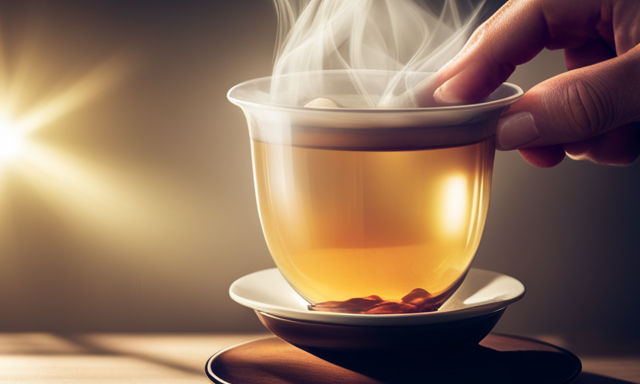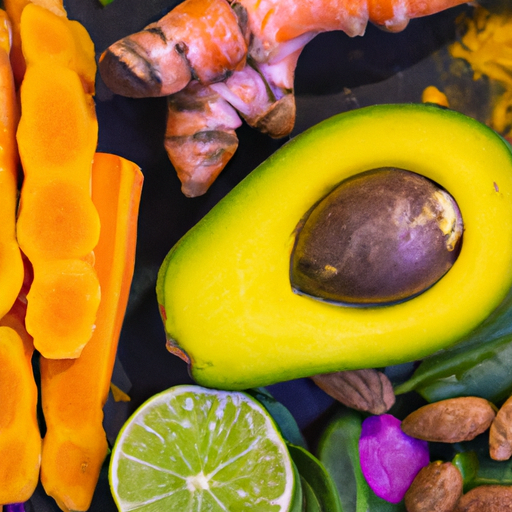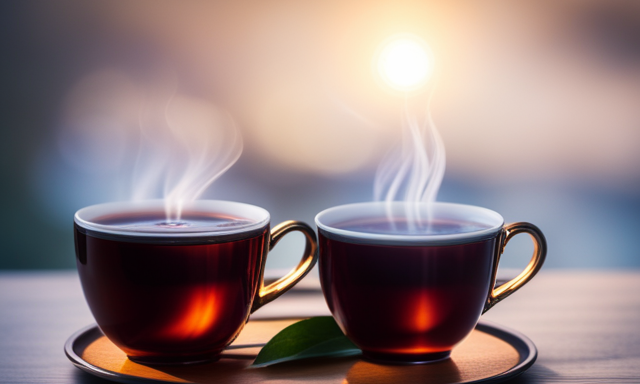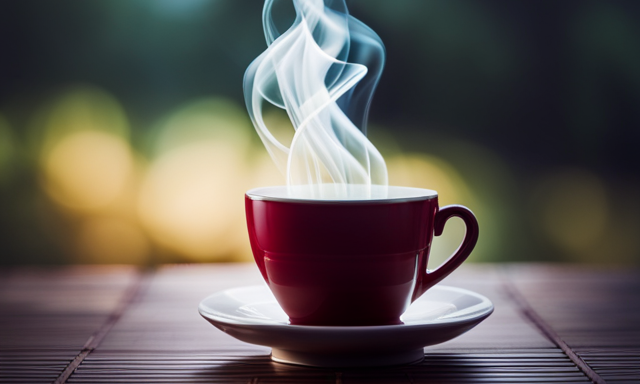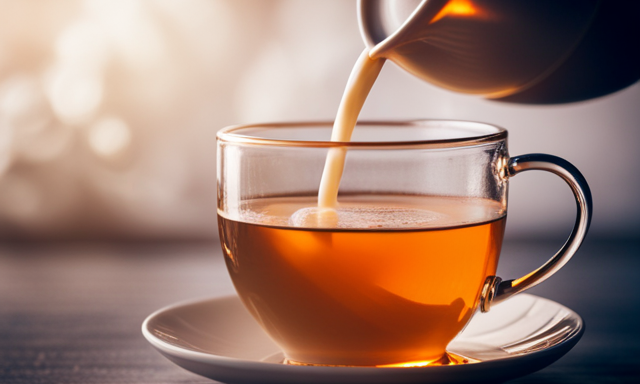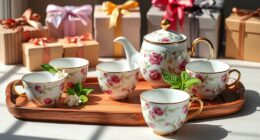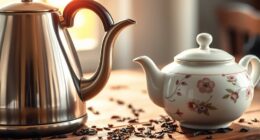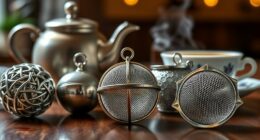As I sit here, sipping on a warm cup of oolong tea, I can’t help but marvel at the intricate flavors dancing on my palate. Oolong tea, with its rich history and unique characteristics, has always intrigued me. But one question has lingered in my mind: how much caffeine does oolong tea actually contain?
In this article, we will delve into the origins of oolong tea and explore the caffeine levels in this beloved beverage. I will compare it to other teas, shed light on its health benefits, and debunk common myths surrounding oolong tea. Join me on this journey as we unravel the secrets of oolong tea and learn how to savor its delightful flavors, all while enjoying its moderate caffeine content.
So, grab your favorite mug, and let’s dive into the world of oolong tea together.
Key Takeaways
- Oolong tea offers a moderate amount of caffeine compared to other teas and coffee.
- Managing caffeine intake from oolong tea is important to avoid potential side effects.
- Gradually reducing oolong tea consumption helps manage caffeine withdrawal symptoms.
- Exploring caffeine-free or low-caffeine alternatives to oolong tea is a viable option.
The Origins of Oolong Tea
Have you ever wondered where oolong tea comes from? Oolong tea has a rich history that dates back centuries. It originated in China, where it is still primarily produced today.
The name ‘oolong’ translates to ‘black dragon’ in Chinese, which is fitting considering its distinctive flavor and appearance. Oolong tea is unique because it undergoes a specific processing method that falls between green and black tea. The leaves are partially oxidized, resulting in a tea that is neither fully fermented nor unfermented.
This careful processing gives oolong tea its complex and nuanced flavor profile. Understanding the different processing methods of oolong tea is important in order to appreciate its unique qualities.
Now, let’s delve into the fascinating world of understanding caffeine levels in tea.
Understanding Caffeine Levels in Tea
When it comes to understanding the caffeine levels in tea, it’s important to know how caffeine is measured. The measurement of caffeine content in tea can vary depending on factors such as the type of tea, the brewing method, and the steeping time.
In the case of oolong tea, the caffeine content can be affected by the oxidation level of the leaves.
How Caffeine is Measured in Tea
The measurement of caffeine in tea is a precise science that illuminates the true potency of oolong tea. Just like measuring caffeine in coffee, determining the caffeine content in tea involves specialized techniques. One common method is known as high-performance liquid chromatography (HPLC), which separates and quantifies different compounds in a sample.
Through this process, scientists are able to accurately measure the amount of caffeine present in oolong tea. Understanding the caffeine levels in tea is important, as it allows individuals to make informed decisions about their caffeine intake, especially considering its impact on sleep quality.
By knowing the exact caffeine content, tea enthusiasts can choose oolong teas with lower caffeine levels if they desire. Moving forward, it is crucial to explore the various factors affecting caffeine content in oolong tea.
Factors Affecting Caffeine Content in Oolong Tea
Understanding the diverse elements that influence the potency of your favorite cup of oolong can be truly fascinating. When it comes to caffeine content, there are several factors that can impact the overall amount present in oolong tea.
These factors include:
-
Tea Processing Methods: The way oolong tea is processed can have a significant impact on its caffeine content. Different methods, such as oxidation levels and roasting, can alter the caffeine levels in the final product.
-
Tea Leaf Quality: The quality of the tea leaves used to make oolong tea can also affect its caffeine content. Higher-quality leaves tend to have higher caffeine levels.
-
Brewing Time and Temperature: The length of time oolong tea is steeped and the water temperature used can influence caffeine extraction. Steeping for longer periods and using hotter water can result in more caffeine being released.
Understanding these factors is essential for tea enthusiasts who want to know the caffeine content in their cup of oolong.
Moving forward, let’s explore how the caffeine content in oolong tea compares to other types of tea.
Comparing Caffeine Content in Different Teas
Oolong tea, with its unique flavor and aroma, is a great choice for tea lovers looking to enjoy a cup with a moderate amount of caffeine. When comparing the caffeine content in different teas, it is important to consider that the levels can vary based on factors such as the type of tea leaves used, the brewing time, and the water temperature.
While oolong tea generally contains less caffeine than black or green tea, it still provides a gentle boost of energy without the jitters. It is worth noting that oolong tea also offers various health benefits, including improving heart health, aiding in weight management, and supporting digestion.
So, not only can you enjoy the moderate caffeine content in oolong tea, but you can also reap the rewards of its health benefits.
Health Benefits of Oolong Tea
Now that we’ve compared the caffeine content in different teas, let’s shift our focus to the health benefits of oolong tea.
Oolong tea is known for its numerous health benefits. One of its potential benefits is aiding in weight loss. Studies have shown that oolong tea can help boost metabolism, increase fat oxidation, and reduce body weight.
Another benefit of oolong tea is its content of polyphenols, which have been found to activate enzymes that enhance fat breakdown. This makes oolong tea a potential ally in weight management.
In addition to weight loss, oolong tea has been shown to help regulate blood sugar levels, promote heart health, and improve brain function. Its unique combination of antioxidants and catechins offers a wide range of health benefits that can support your overall well-being.
So, let’s explore how to enjoy oolong tea for maximum benefits and continue our journey towards discovering the wonders of this remarkable beverage.
How to Enjoy Oolong Tea for Maximum Benefits
When it comes to enjoying oolong tea for maximum benefits, there are a few key points to keep in mind.
First, the brewing method is crucial in order to bring out the flavors and health benefits of the tea. I recommend using water that is around 190-200°F and steeping the tea leaves for about 3-5 minutes.
Additionally, pairing oolong tea with certain foods can enhance the overall experience and provide additional health benefits. For example, oolong tea pairs well with seafood, fruits, and light desserts, as it complements their flavors and aids in digestion.
Taking the time to savor the aroma and taste of oolong tea can also enhance the enjoyment and maximize the benefits. Allow yourself to fully experience the tea by taking small sips and paying attention to the flavors and sensations it brings.
Finally, incorporating oolong tea into your daily routine can help you reap its benefits over time. Whether you choose to have it in the morning to kickstart your day or as a calming ritual in the evening, making oolong tea a regular part of your routine can enhance your overall well-being.
In summary, by paying attention to the brewing method, pairing it with compatible foods, savoring the taste, and incorporating it into your daily routine, you can enjoy oolong tea for maximum benefits.
Brewing Methods and Recommendations
To enhance your oolong tea experience, you may consider exploring various brewing methods and following recommended techniques to bring out its unique flavors and aromas. Here are some brewing techniques and ideal water temperature for brewing oolong tea:
-
Gongfu style brewing: This traditional Chinese method involves using a small teapot and a high leaf-to-water ratio. It brings out the full-bodied flavor and complexity of oolong tea.
-
Western style brewing: This method is more suitable for beginners or those who prefer a milder taste. Use a larger teapot or a teabag and steep the tea for 3-5 minutes.
-
Water temperature: Oolong tea is best brewed at around 185-205°F (85-96°C). This allows the leaves to unfurl and release their flavors gradually.
By experimenting with different brewing methods and temperatures, you can discover your preferred way of enjoying oolong tea. This knowledge will come in handy when it comes to pairing oolong tea with food.
Pairing Oolong Tea with Food
Enhance your oolong tea experience by exploring the art of pairing it with a variety of delectable food choices. Oolong tea’s unique flavor profiles make it a versatile beverage that can be enjoyed with a wide range of desserts. The combination of oolong tea’s floral and fruity notes with the sweetness of desserts creates a delightful harmony on the palate. Some popular pairings include oolong tea with creamy cakes, delicate pastries, or rich chocolate desserts.
In addition to its delicious taste, oolong tea also offers benefits for digestion. It contains polyphenols and catechins that can help promote a healthy digestive system. These compounds have been shown to enhance gut health, reduce inflammation, and improve nutrient absorption. So, enjoying a cup of oolong tea after a meal can aid in digestion and provide a soothing effect.
Transitioning to managing caffeine intake from oolong tea, it’s important to be mindful of the amount consumed to avoid any potential side effects.
Managing Caffeine Intake from Oolong Tea
If you’re looking to keep your caffeine intake in check, oolong tea might just be your new best friend. It offers a moderate amount of caffeine compared to other teas and coffee, making it a great option for managing caffeine intake.
Here are three strategies for managing caffeine intake from oolong tea:
-
Gradual Reduction: If you’re trying to cut back on caffeine, start by gradually decreasing your oolong tea consumption. This can help manage caffeine withdrawal symptoms and make the transition easier.
-
Limiting Daily Intake: Set a limit on the number of cups of oolong tea you consume each day. This allows you to enjoy the benefits of oolong tea while still keeping your caffeine intake within a manageable range.
-
Exploring Alternatives: If you’re concerned about the caffeine content in oolong tea, consider exploring other caffeine-free or low-caffeine beverage options. Herbal teas or decaffeinated oolong tea can be great alternatives.
By managing your caffeine intake from oolong tea, you can enjoy its flavors and varieties without worrying about excessive caffeine consumption.
Now, let’s explore the exciting world of flavors and varieties of oolong tea.
Exploring Flavors and Varieties of Oolong Tea
Delving into the diverse world of oolong tea will take your taste buds on a captivating journey through a myriad of delightful flavors and enticing varieties. Oolong tea is known for its complex, nuanced taste profile. It offers a wide range of flavors from floral and fruity to toasty and nutty.
Each variety of oolong tea has its own unique flavor characteristics. This makes it an exciting experience to explore different types. To fully appreciate the flavors of oolong tea, you can attend oolong tea tasting events. Experts guide you through a sensory experience, helping you identify the subtle notes and aromas. These events provide an opportunity to discover new favorites and expand your palate.
Transitioning into the next section about oolong tea in traditional Chinese culture, it is fascinating to see how this rich beverage has been an integral part of Chinese customs for centuries.
Oolong Tea in Traditional Chinese Culture
Oolong tea has long been revered in traditional Chinese culture. It has over 400 years of history and a significant presence in daily rituals and ceremonies.
The rich heritage of traditional Chinese tea ceremonies is deeply intertwined with the symbolism of oolong tea. It is often served during important occasions and gatherings, symbolizing respect, hospitality, and harmony.
The preparation and serving of oolong tea is considered an art form. Specific rituals and techniques are followed to create the perfect cup. The tea leaves are carefully selected, brewed, and poured into small cups, with each step holding its own meaning and significance.
The aroma and taste of oolong tea are appreciated and savored, enhancing the overall experience of the ceremony.
Transitioning to the subsequent section about common myths and misconceptions about oolong tea, it is important to understand the cultural significance and traditions surrounding this beloved tea.
Common Myths and Misconceptions about Oolong Tea
When it comes to weight loss, there is a common misconception that oolong tea can magically shed the pounds. However, it’s important to note that while oolong tea may have some potential benefits for weight management, it is not a miracle solution.
Additionally, there are various health claims surrounding oolong tea, such as boosting metabolism and reducing cholesterol levels. While some studies suggest these effects, more research is needed for conclusive evidence.
Oolong Tea and Weight Loss
Exploring the benefits of oolong tea for weight loss, sipping a cup of this aromatic brew can be like taking a step towards a healthier, slimmer you.
Oolong tea has long been associated with boosting metabolism and aiding in weight loss. The catechins found in oolong tea have been shown to increase energy expenditure and fat oxidation, helping the body burn calories more efficiently.
Additionally, oolong tea can help regulate blood sugar levels, preventing spikes and crashes that can lead to cravings and overeating. Studies have also shown that oolong tea can reduce the absorption of dietary fat and cholesterol.
So, if you’re looking to shed a few pounds, incorporating oolong tea into your daily routine may be a beneficial choice.
Transitioning into the subsequent section about ‘oolong tea and health claims’, let’s delve deeper into the other potential benefits this tea has to offer.
Oolong Tea and Health Claims
One cannot deny the potential health benefits associated with incorporating oolong tea into their daily routine.
Oolong tea has been shown to have positive effects on cardiovascular health. Studies have suggested that oolong tea can help lower blood pressure and reduce the risk of heart disease.
The antioxidants found in oolong tea may also help improve digestion by promoting the growth of beneficial gut bacteria and reducing inflammation in the digestive system. These effects may lead to better nutrient absorption and a healthier gut overall.
However, it is important to enjoy oolong tea in moderation, as excessive consumption may lead to side effects such as caffeine sensitivity or disrupted sleep.
In the next section, we will explore the conclusion of enjoying oolong tea in moderation.
Conclusion: Enjoying Oolong Tea in Moderation
In moderation, oolong tea can be a delightful and caffeinated treat. It provides a balanced amount of caffeine that can give you a gentle pick-me-up without the jitters. When it comes to managing caffeine intake, oolong tea is a great option. It contains less caffeine than black tea but more than green tea, making it a middle ground for those looking to reduce their caffeine consumption.
Additionally, oolong tea has been linked to heart health benefits. Studies have shown that regular consumption of oolong tea may help improve heart health by reducing the risk of cardiovascular diseases. The antioxidants present in oolong tea have been found to have protective effects on the heart, helping to lower blood pressure and cholesterol levels.
Overall, enjoying oolong tea in moderation can be a healthy and flavorful addition to your daily routine. Just remember to listen to your body and consume it within your personal caffeine limits.
Frequently Asked Questions
How does the caffeine content in oolong tea compare to other beverages like coffee and energy drinks?
The caffeine content in oolong tea is lower than coffee and energy drinks, making it a healthier choice for those concerned about their caffeine intake. Consuming less caffeine can also improve sleep quality.
Can oolong tea be consumed by pregnant women or individuals with certain health conditions?
Pregnant women should limit caffeine consumption, including oolong tea, due to potential risks. Individuals with certain health conditions should consult their healthcare provider before consuming tea or any caffeinated beverages.
Is it possible to decaffeinate oolong tea at home?
Yes, it is possible to decaffeinate oolong tea at home. There are various methods, such as using hot water to remove caffeine. This process can result in a decaf oolong tea that is caffeine-free.
Does the caffeine content in oolong tea vary depending on the brewing method or steeping time?
The caffeine content in oolong tea can vary depending on the brewing method and steeping time. For example, longer steeping times and higher temperatures may extract more caffeine, resulting in a higher caffeine content in the tea.
Are there any potential side effects or risks associated with consuming oolong tea in excessive amounts?
Excessive consumption of oolong tea may pose potential health risks. While moderate intake is generally safe, excessive amounts of oolong tea can lead to side effects such as caffeine-related issues, digestive problems, and mineral imbalances.
Conclusion
In conclusion, after analyzing the caffeine content in oolong tea, it is evident that this tea falls in the middle range when compared to other teas. While it does contain caffeine, the levels are lower than in black tea but higher than in green tea.
It is important to note that the health benefits of oolong tea, such as improved digestion and weight management, make it a great addition to a balanced diet. So, next time you enjoy a cup of oolong tea, savor its flavors and reap its benefits, all while keeping moderation in mind.

